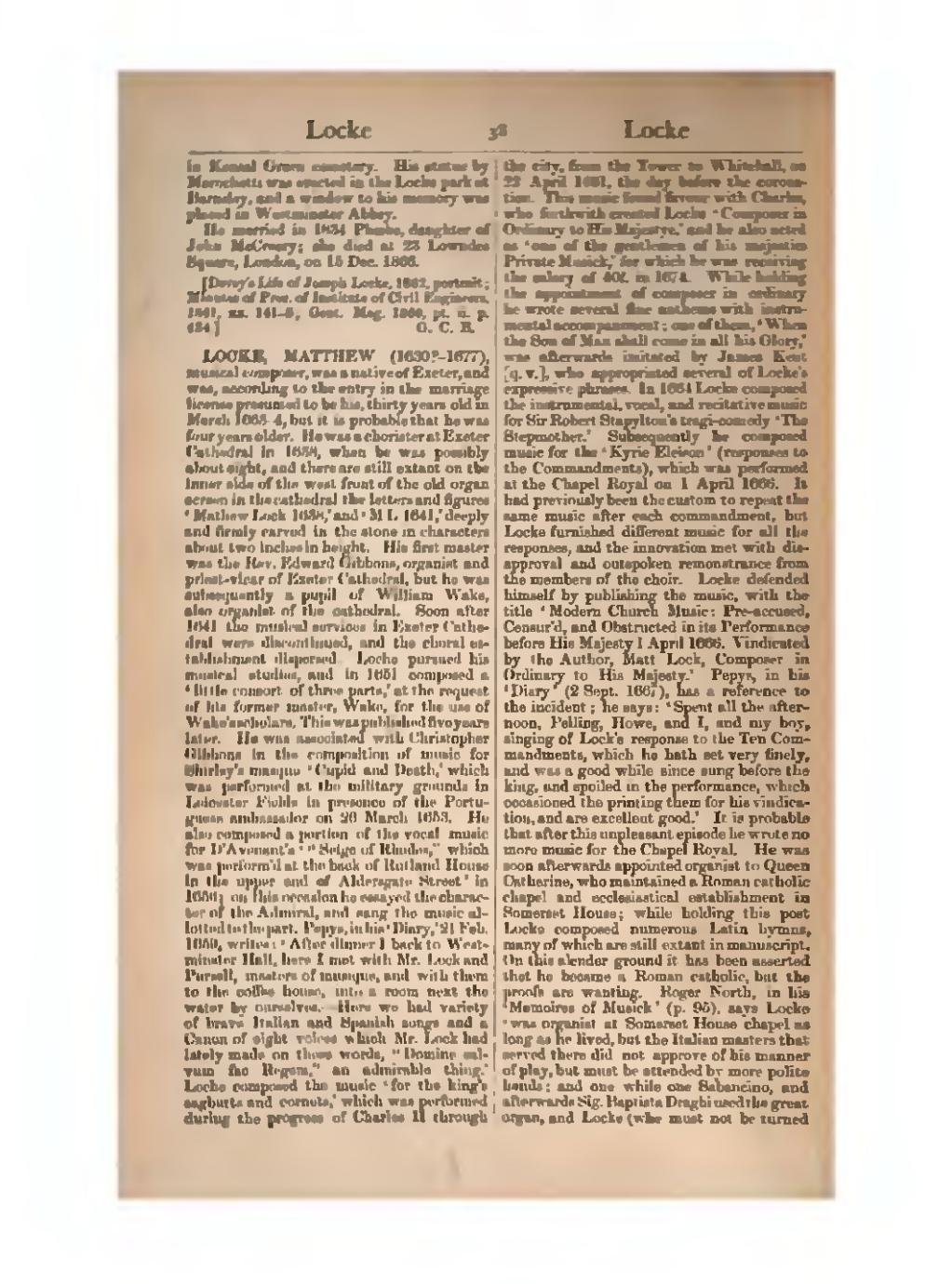in Kensal Green cemetery. His statue by Marochetti was erected in the Locke park at Barnsley, and a window to his memory was placed in Westminster Abbey.
He married in 1834 Phœbe, daughter of John McCreery; she died at 23 Lowndes Square, London, on 15 Dec. 1866.
[Devey's Life of Joseph Locke, 1862, portrait; Minutes of Proc. of Institute of Civil Engineers, 1861, xx. 141-8; Gent. Mag. 1860, pt. ii. p. 434.]
LOCKE, MATTHEW (1630?–1677), musical composer, was a native of Exeter, and was, according to the entry in the marriage license presumed to be his, thirty years old in March 1663-4, but it is probable that he was four years older. He was a chorister at Exeter Cathedral in 1638, when he was possibly about eight, and there are still extant on the inner side of the west front of the old organ screen in the cathedral the letters and figures 'Mathew Lock 1638,' and 'M L 1641,' deeply and firmly carved in the stone in characters about two inches in height. His first master was the Rev. Edward Gibbons, organist and priest-vicar of Exeter Cathedral, but he was subsequently a pupil of William Wake, also organist of the cathedral. Soon after 1641 the musical services in Exeter Cathedral were discontinued, and the choral establishment dispersed. Locke pursued his musical studies, and in 1651 composed a 'little consort of three parts,' at the request of his former master, Wake, for the use of Wake's scholars. This was published five years later. He was associated with Christopher Gibbons in the composition of music for Shirley's masque 'Cupid and Death,' which was performed at the military grounds in Leicester Fields in presence of the Portuguese ambassador on 26 March 1653. He also composed a portion of the vocal music for D'Avenant's '“Seige of Rhodes,” which was perform'd at the back of Rutland House in the upper end of Aldersgate Street' in 1656; on this occasion he essayed the character of the Admiral, and sang the music allotted to the part. Pepys, in his 'Diary,' 21 Feb. 1659, writes: 'After dinner I back to Westminster Hall, here I met with Mr. Lock and Pursell, masters of musique, and with them to the coffee house, into a room next the water by ourselves.—Here we had variety of brave Italian and Spanish songs and a Canon of eight voices which Mr. Lock had lately made on these words, “Domine salvum fac Regem,” an admirable thing.' Locke composed the music 'for the king's sagbutts and cornets,' which was performed during the progress of Charles II through the city, from the Tower to Whitehall, on 22 April 1661, the day before the coronation. This music found favour with Charles, who forthwith created Locke 'Composer in Ordinary to His Majestye,' and he also acted as 'one of the gentlemen of his majesties Private Musick,' for which he was receiving the salary of 40l. in 1674. While holding the appointment of composer in ordinary he wrote several fine anthems with instrumental accompaniment; one of them, 'When the Son of Man shall come in all his Glory,' was afterwards imitated by James Kent [q. v.], who appropriated several of Locke's expressive phrases. In 1664 Locke composed the instrumental, vocal, and recitative music for Sir Robert Stapylton's tragi-comedy 'The Stepmother.' Subsequently he composed music for the 'Kyrie Eleison' (responses to the Commandments), which was performed at the Chapel Royal on 1 April 1666. It had previously been the custom to repeat the same music after each commandment, but Locke furnished different music for all the responses, and the innovation met with disapproval and outspoken remonstrance from the members of the choir. Locke defended himself by publishing the music, with the title 'Modern Church Music: Pre-accused, Censur'd, and Obstructed in its Performance before His Majesty 1 April 1666. Vindicated by the Author, Matt Lock, Composer in Ordinary to His Majesty.'. Pepys, in his 'Diary' (2 Sept. 1667), has a reference to the incident; he says: 'Spent all the afternoon, Pelling, Howe, and I, and my boy, singing of Lock's response to the Ten Commandments, which he hath set very finely, and was a good while since sung before the king, and spoiled in the performance, which occasioned the printing them for his vindication, and are excellent good.' It is probable that after this unpleasant episode he wrote no more music for the Chapel Royal. He was soon afterwards appointed organist to Queen Catherine, who maintained a Roman catholic chapel and ecclesiastical establishment in Somerset House; while holding this post Locke composed numerous Latin hymns, many of which are still extant in manuscript. On this slender ground it has been asserted that he became a Roman catholic, but the proofs are wanting. Roger North, in his 'Memoires of Musick' (p. 95), says Locke 'was organist at Somerset House chapel as long as he lived, but the Italian masters that served there did not approve of his manner of play, but must be attended by more polite hands; and one while one Sabancino, and afterwards Sig. Baptista Draghi used the great organ, and Locke (who must not be turned
